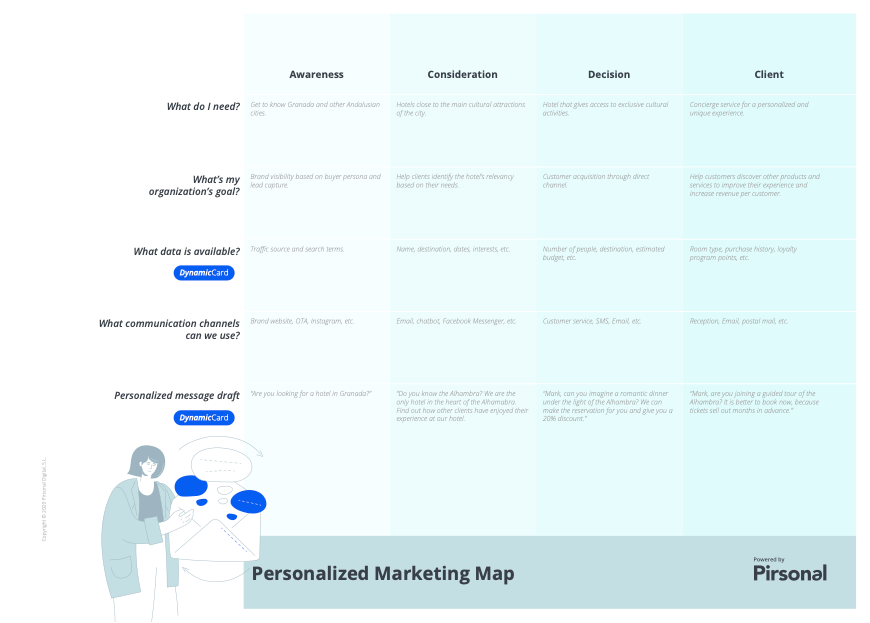According to recent reports, B2B marketing executives are feeling the pinch in their budgets this year and have been forced to make some necessary cuts. As a result, the B2B marketing landscape has been compelled to increase their focus on marketing performance.
And this is a healthy move.
To optimize the performance of your B2B marketing, it’s crucial to have a clear understanding of your target audience. Additionally, utilizing marketing automation and state-of-the-art AI technology can help streamline your processes and truly set you apart from the competition.
Furthermore, the majority of B2B buyers expect you to deliver a personalized experience across the buyer journey. Finally, analyzing data analytics is an essential step toward making informed decisions that ultimately lead to greater success in your marketing efforts.
Focusing on these specific areas will boost your B2B marketing impact and help you reach your goals without overspending time and resources. Let’s see how.
In this article, we will discuss the key steps you can take to improve the performance of your B2B marketing strategy.
Understanding the B2B Landscape
Before diving into the specifics of optimizing your marketing strategy, it is essential to have a clear understanding of the current B2B landscape.
In recent years, B2B marketing has undergone significant changes. With the rise of digital channels, the democratization of AI, and the maturity of B2B buyers, it is now easier than ever for B2B marketers to reach their target audience.
Or, is it?
I’ve been in B2B marketing since 2011 or so. In my opinion, marketing to businesses can be tougher nowadays. To stand out in a crowded market with many competitors, you must clearly and uniquely communicate your value proposition to potential clients.
And this has not only to do with quantity but a lot more with quality.
Let me explain.
Key decision-makers already understand the dynamics of buying through digital channels. The Covid-19 global pandemic accelerated the process.
I remember when a few years ago I decided that I was not going to visit potential clients’ offices anymore. I had simply realized that I could do everything online without chasing potential buyers on-site.
No more taxis, trains or airplanes. More time and better clients awaited me, pretty much anywhere in the world.
But as customers evolve, so does the marketing landscape. So, to optimize your marketing efforts, you need to focus on clearly understanding your target audience.
This sounds like déjà vu for most marketers.
But, for real, you need to go granular to succeed.
Let’s see how.
Conducting a Marketing Audit
One of the first steps to optimizing your marketing strategy in B2B is to conduct a comprehensive marketing audit. This involves taking a detailed look at your current marketing efforts to identify areas for improvement.
A marketing audit should include product positioning and messaging, and pricing. It should include an analysis of your website, social media channels, email marketing campaigns, and any other marketing activities you are currently engaged in.
Identifying Your Target Audience
Once you have conducted a marketing audit, the next step is to identify your target audience. This involves developing a clear understanding of who your ideal customer is and what their needs and pain points are.
Here is my rule of thumb:
- If you have good experience identifying audiences, to succeed, be granular.
- If you don’t have a lot of experience, keep it simple at this stage.
In both cases, there are a few critical things you’ll need to consider.
To identify your target audience, find the pain points of the people involved in the buying committee and other influential people within the organization.
This involves understanding the challenges they face and the problems they need to solve with your offering.
Remember that customers’ pain points, needs, and requirements can shift as they search for information on how to improve or fix something in their organization.
Also, remember that sometimes their “best solution” is inaction, simply because they couldn’t figure out how to get help.
This also depends on the level of complexity of the challenge they are facing.

For example, in our case at Pirsonal, we target different target audiences. We adapt our sales approach based on who we are speaking with during introductory, demonstration, and proposal calls with sales opportunities.
This also helps us serve them better. It helps us close more sales, and adapt our offering as feedback consolidates over time.
Sometimes the complete sales process will be managed by an Account Manager from an agency on behalf of one of their clients.
Sometimes, it will be led by a creative user as part of an in-house marketing team. Developers are sometimes responsible for completing the task. Occasionally, it may come from a colleague who holds a position at the C-level or VP-level.
The point is, marketing and sales are 100% connected and dynamic.
Your marketing and sales cycle can’t be always the same through the marketing funnel.
Nowadays, you need to constantly adapt your target audience through the lens of the different individuals that operate in the buying process.
This can get even more intense if your target market changes after shifting product positioning after performing this audit.
B2B customers have different pain points. And your marketing needs to speak to this.
When you understand these pain points, you can develop marketing strategies, tactics, and messages that tackle these challenges and present your product or service as a solution.
Finding Your Audience
To find your audience, you must map out the journey of your buyer. A journey map is the steps a business goes through when purchasing.
This includes the awareness stage, consideration stage, and decision stage. And, if you are focused on retention, then you’ll add an engagement stage to extend lifetime value (LTV).
When you understand the buyer’s journey, you can create marketing messages that speak to each stage and guide potential customers toward a purchasing decision.
To effectively improve interactions with your customers, you need to gather structured data about their behavior and preferences. This will help you better understand your customers and guide your future interactions.
This involves understanding how your target audience interacts with your marketing messages and your product or service. This, then, takes you to the personalization arena.
As a marketing leader, you must collaborate with your sales peers. Gather and share insights from the sales department within your organization.
Understand the contextual information they have acquired thanks to multiple interactions between sales reps and potential customers.
Personalizing the customer experience
A strategy I recommend for doing this is building a personalized marketing map. Your fellow customer experience professionals are sure to love this!
A personalized marketing map—that’s what I call it—is a tool I use to help our clients and myself know and visualize the type of personalized customer interactions and pieces of content an audience should see in order to take action.
Here you have an example:

The following video explains how I use it. Watch it now to learn how you can use it as well to create more effective personalized marketing campaigns with online videos.
These are the components a personalized marketing map takes into account:
- The marketing or sales stage.
- The customer data you have access to at each stage.
- The type of content that better fits the user’s needs.
- Your business goals at every stage.
- The customer’s goals and context at every stage.
When you use a personalized marketing map, you can ensure that your marketing efforts are focused and effective and that you are reaching your target consumers.
Then, redefine your audience through the lens of the most relevant marketing metrics and KPI for your business.
Analyze website traffic, email open rates, and customer feedback. Add mechanisms to gather customer data.
Also, talk to sales and support teams to identify common questions, concerns, and answers and the people behind those.
You can also use AI tools like ChatGPT to identify common questions from content you share with the AI tool.
When you pay attention to your target audience, you see areas where you can improve. From there, you can tailor your marketing messages to better resonate with your target audience.
Developing a Content Strategy
Now that you’ve found your target audience and how to get more information about them throughout their buyer and customer journey, it’s time to focus on creating or updating your content marketing for better performance.
A key component of any successful marketing strategy is a content strategy focused on the top marketing channels to reach B2B buyers.
This involves creating high-quality content that is relevant and valuable to your target audience.
Ensure your content caters to your target audience’s needs and preferences at each stage of their experience to improve performance.
Your content strategy should include a mix of different types of content, such as blog posts, videos, infographics, and social media posts.
Every format and content should address different buyer personas and their stage.
In the following video, I explain how to do this effectively. In the tutorial, I use video as the type of content. I explain what type of video and distribution channels work best depending on a mix of factors like the journey stage, customer experience dimension, potential customer pain points, and the brand’s goals.
Leveraging Marketing Automation
Marketing automation can be a powerful tool for optimizing your marketing strategy. Automation allows you to streamline your marketing processes and improve efficiency, freeing up more time to focus on strategy and creativity.
My message here is quite simple.
Talk to Sales, Customer Support, IT, and other customer-facing teams. Gather feedback in terms of what could be automated to help your organization save time.
Marketing automation can be used for a wide range of tasks, from email marketing to lead generation in B2B and scoring.
But it’s not only about saving time. With marketing automation, businesses can also serve their customer base better. Marketing automation can help your business become customer-centric.
Localizing Social Media Marketing
Any experienced marketing manager knows that social media has become an essential part of the B2B digital marketing landscape. With the use of AI tools to analyze and create content, the current social media landscape is drastically changing.
With millions of users on platforms like LinkedIn, Twitter, and Facebook, social media provides a vast audience for marketers to reach. But mature B2B buyers are looking for quality content that helps them make wise decisions.
Content creation in digital marketing has become extremely easy thanks to the use of AI. To perform better through social media channels, you need to make sure your content is both entertaining and useful.
Also, localization in digital marketing can be a big and cost-effective growth driver.
Share unique experiments, talk from experience, and find creative ways to engage with your unique audience depending on the channel they interact with you.
Make sure to keep a consistent and strong brand identity across all content and messages. Both B2B and B2C customers find it easier to buy from brands they trust because of the attributes associated with the brands.
Investing in SEO
AI can be used to improve SEO in several ways to optimize your marketing. One way is to use AI-powered tools to conduct keyword research and identify high-value keywords to target in your content.
These tools can analyze search data and provide insights into how users are searching for information related to your business.
Another way AI can improve SEO is by using natural language processing (NLP) algorithms to optimize your content. These algorithms can analyze your content and identify areas where you can improve your keyword usage, sentence structure, and other factors that impact SEO.
AI can also be used to automate routine SEO tasks, such as optimizing meta descriptions and title tags. This can free up time for marketers to focus on more creative and strategic tasks.
Finally, AI-powered chatbots can help improve customer engagement and reduce bounce rates on your website, which can indirectly improve your SEO ranking.
Chatbots can keep users on your website longer and improve conversion rates by giving personalized and helpful responses to their questions and concerns.
Personalizing Your Marketing
Personalization is another critical way to improve the performance of your marketing strategy in the current B2B landscape. As I shared, by tailoring your messages and content to your target audience’s needs and interests, you can increase engagement and improve conversion rates.
Personalization means tailoring your messages to the individual recipient. You can do this by using their name, providing recommendations based on their past customer behavior, and dividing your audience to deliver more relevant content.
More and more, companies are relying on first-party data to improve customer experience, marketing, and sales efforts.
Any content type can be personalized. From direct mail to email marketing and landing pages.
It also involves using the type of content your audience loves. For instance, most people love video content. Videos can be personalized without you even lifting a finger.
In terms of software to create personalized video content, make sure to choose a platform that adapts to the way you want to optimize processes, workflows, and strategies.
For instance, most video personalization platforms are meant for big audiences only or can’t scale and adapt to compliance requirements.
This is why at Pirsonal we have an approach that adapts to most marketing teams and organizations.
Pirsonal adapts to the expertise of your marketing team, audience size, and workflow to help you succeed so that anyone in your team can successfully manage a personalized video program through flexible software and hands-on help.
If you want to learn more about personalized video marketing, here you have a complete guide with examples and case studies. Make sure to go over this guide now to learn more about personalized video marketing.
Personalization can help you build stronger relationships with your customers and prospects, ultimately leading to better business outcomes.
Leveraging Artificial Intelligence
You can improve your marketing strategy by using artificial intelligence (AI) to speed up research and generate fresh ideas.
AI tools like ChatGPT can help you quickly analyze data and extract insights that would take humans much longer to find.
ChatGPT can also assist with content creation by generating ideas and helping you write copy that is optimized for SEO.
By using AI tools, you can save time and resources while improving the quality and effectiveness of your marketing efforts. AI can help you stay ahead of the competition and adapt to the rapidly changing B2B landscape.
Measuring Your Results
Finally, it is essential to measure the results of your marketing efforts continually. This involves tracking metrics like website traffic, social media engagement, email open rates, and lead conversion rates.
By measuring your results, you can identify what is working and what is not and make data-driven decisions to optimize your marketing strategy.
Takeaways
B2B companies can boost their marketing performance by doing a marketing audit, finding their target audience, creating personalized content, automating marketing, localizing social media, improving SEO, and measuring outcomes.
By doing this, they can enhance their marketing and reach their business goals.

